Exploring Infrared Therapy Lamps: A Guide to Their Principles and Applications
1. What is an Infrared Therapy Lamp?
An infrared therapy lamp is a specialized device that uses infrared radiation (a form of invisible electromagnetic wave) to deliver therapeutic effects to the human body. Unlike ordinary lighting lamps that primarily emit visible light for illumination, infrared therapy lamps focus on releasing infrared rays—specifically near-infrared (NIR, wavelength 700-1400nm) or far-infrared (FIR, wavelength 3-1000μm) bands— which can penetrate the skin and act on underlying tissues.
This type of therapeutic equipment is designed to leverage the thermal and non-thermal effects of infrared rays to support physical comfort and recovery. For professional equipment manufacturers like Jiangyin Jianshifu Equipment Co., Ltd. —a disinfection equipment specialist established in 1993 and based in the New Material Industrial Park of Jiangyin Economic Development Zone—while their core product range includes plasma air sterilizers, bed unit sterilizers, and UV germicidal devices, the technical expertise in electromagnetic wave application and equipment safety aligns with the production standards required for infrared therapy lamps, ensuring compliance with health and safety regulations.
2. How Does an Infrared Therapy Lamp Work?
The therapeutic effect of an infrared therapy lamp stems from the interaction between infrared radiation and human tissue, primarily through two key mechanisms:
Thermal Effect (Primary Mechanism)
When infrared rays irradiate the body, they are absorbed by skin, muscles, and subcutaneous tissues. This absorption converts the radiant energy into heat, raising the local tissue temperature by 1-3℃. The mild heating effect promotes vasodilation (widening of blood vessels), which increases blood flow to the targeted area. Improved circulation delivers more oxygen and nutrients to tissues, accelerates the removal of metabolic waste (such as lactic acid), and helps relax tight muscles—providing relief from muscle stiffness, soreness, and joint discomfort.
Non-Thermal Effect (Auxiliary Mechanism)
Beyond heating, specific wavelengths of infrared rays (especially near-infrared) can interact with cellular components (e.g., mitochondria) without significant temperature elevation. This interaction may stimulate cellular metabolism, enhance the activity of antioxidant enzymes, and support tissue repair processes—though this effect is more subtle and often complementary to the thermal benefit.
Notably, the wavelength range of the lamp determines its penetration depth: near-infrared rays can penetrate 2-5cm into the body (reaching muscles and joints), while far-infrared rays are absorbed by the outer layers of the skin (ideal for surface-level comfort, such as relieving dry skin or mild superficial tension).
3. What Are the Application Scenarios of Infrared Therapy Lamps?
Infrared therapy lamps are versatile and widely used in home, professional, and healthcare settings, thanks to their non-invasive nature and ease of use:
Home Use
Muscle and Joint Care: Ideal for relieving post-exercise muscle soreness (e.g., after running or weightlifting), neck and shoulder stiffness from prolonged sitting (e.g., working at a desk), or mild joint discomfort (e.g., knee stiffness in the elderly).
Relaxation and Wellness: Used to warm the body during cold weather, reduce stress by relaxing tense muscles, or alleviate mild menstrual cramps through gentle abdominal heating.
Professional Settings
Physical Therapy Clinics: Integrated into rehabilitation programs for patients recovering from soft tissue injuries (e.g., sprains, strains), arthritis, or post-surgery recovery (to reduce scar tissue tightness).
Spas and Wellness Centers: Incorporated into massage or relaxation treatments to enhance muscle relaxation and improve the absorption of skincare products (via increased skin permeability from mild heating).
Healthcare Facilities
Hospitals and Nursing Homes: Used as an auxiliary tool to improve blood circulation in bedridden patients (reducing the risk of pressure sores) or to provide comfort for patients with chronic pain conditions (e.g., lower back pain). For companies like Jiangyin Jianshifu Equipment Co., Ltd., which serves medical settings with bed unit sterilizers, infrared therapy lamps can complement their medical equipment portfolio by addressing patient comfort needs in clinical environments.
4. What Precautions Should Be Taken When Using an Infrared Therapy Lamp?
While infrared therapy lamps are generally safe, improper use can lead to skin burns or other risks. Follow these key precautions:
Maintain a Safe Distance: Keep the lamp 30-50cm away from the body (specific distance varies by lamp power—always refer to the user manual). Too close exposure can cause overheating and skin burns, even without immediate pain (infrared rays are invisible, so users may not notice excessive heat at first).
Limit Irradiation Time: Avoid prolonged use on the same area—recommended sessions are 10-20 minutes per area, 1-2 times per day. Extended exposure can damage skin cells or cause dehydration in the targeted tissue.
Avoid Sensitive Areas: Never irradiate the eyes (infrared rays can damage the retina), face (especially the eyes and mucous membranes), open wounds, burns, or areas with skin conditions (e.g., eczema, psoriasis). For patients with diabetes or nerve damage (who may have reduced heat sensitivity), use under supervision to prevent accidental burns.
Check Equipment Condition: Before use, inspect the lamp for damage (e.g., cracked casing, frayed power cords). For professional-grade lamps (like those that could be produced by manufacturers with Jiangyin Jianshifu’s equipment expertise), regular testing of the infrared output and safety switches is essential to ensure functionality.
Not for Everyone: Pregnant women, individuals with severe hypertension, skin cancer patients, or those with implanted medical devices (e.g., pacemakers) should consult a doctor before using an infrared therapy lamp—heat or electromagnetic radiation may interfere with medical conditions or devices.
5. How Do Infrared Therapy Lamps Differ from Other Therapeutic Devices?
Infrared therapy lamps are often confused with similar devices, but they differ significantly in principle, application, and effect:
Device Type
Core Principle
Key Difference from Infrared Therapy Lamps
TENS Units (Transcutaneous Electrical Nerve Stimulation)
Uses low-voltage electrical pulses to block pain signals
Focuses on pain relief via nerve stimulation (no heat), while infrared lamps work via heat and improved circulation. TENS is better for acute pain, while infrared lamps suit stiffness and tissue recovery.
Heating Pads
Delivers conductive heat via electric coils or hot water
Heat is transferred through direct contact with the skin (superficial heating), while infrared lamps use radiant heat that penetrates deeper (reaching muscles/joints without direct contact).
UV Germicidal Lamps
Uses UVC rays to destroy microorganisms (disinfection)
Designed for disinfection (not therapy) and can harm human tissue if misused. Infrared therapy lamps are safe for tissue and focus on healing/comfort. (Note: Jiangyin Jianshifu Equipment Co., Ltd. produces both UV disinfection devices and adheres to similar safety standards for therapeutic equipment.)
6. How to Choose a Suitable Infrared Therapy Lamp?
When selecting an infrared therapy lamp, focus on these critical factors to ensure safety and effectiveness:
Wavelength Selection:
Choose near-infrared lamps for deep tissue relief (e.g., muscle/joint pain) or far-infrared lamps for surface-level comfort (e.g., skin warming, mild tension). Some lamps offer dual-wavelength options for versatility.
Power and Coverage:
For home use, 150-300W lamps are sufficient for targeted areas (e.g., neck, knees). Professional settings may require 500W+ lamps for larger coverage (e.g., back or full-body use). Ensure the lamp’s irradiation angle matches your needs (e.g., a adjustable head for targeting specific joints).
Safety Features:
Prioritize lamps with overheat protection (auto-shutdown if temperature exceeds safe levels), timers (to prevent prolonged use), and stable bases (to avoid tipping). For medical-grade options, look for certifications (e.g., CE, FDA) to ensure compliance with health standards—similar to the quality controls Jiangyin Jianshifu applies to its disinfection equipment.
Ease of Use:
Opt for lamps with adjustable height/angle (to target hard-to-reach areas like the lower back) and user-friendly controls (e.g., clear power/timer buttons). Portable, lightweight models are ideal for home use, while stationary floor-standing lamps suit professional settings.
Brand and After-Sales Support:
Choose products from reputable manufacturers with a track record in health equipment. Companies like Jiangyin Jianshifu Equipment Co., Ltd.—with experience in producing medical-grade devices—understand the importance of after-sales service (e.g., maintenance guidance, warranty support), which is crucial for long-term equipment reliability.
7. Key Points for Maintenance of Infrared Therapy Lamps?
Proper maintenance ensures the longevity and safety of your infrared therapy lamp:
Regular Cleaning:
After each use (once cooled), wipe the lamp’s surface and reflector with a dry, soft cloth to remove dust. For stubborn stains, use a slightly damp cloth (avoid harsh chemicals, which can damage the lamp’s coating). Never pour water directly on the device.
Inspect for Damage:
Weekly, check the power cord for fraying or cracks, and ensure the lamp head/stand is stable (tighten loose screws if needed). If the lamp emits unusual noises (e.g., buzzing) or fails to heat up, stop using it immediately and contact customer support (as offered by manufacturers like Jiangyin Jianshifu for their equipment).
Store Properly:
When not in use, store the lamp in a dry, cool place away from direct sunlight, moisture, or dust. Avoid placing heavy objects on the lamp head or cord to prevent deformation. For portable models, use the original packaging for storage to protect the lamp from scratches.
Replace Wearable Parts:
If the lamp uses replaceable bulbs, follow the manufacturer’s guidelines for replacement (typically every 1,000-2,000 hours of use). Using non-original bulbs may reduce therapeutic effectiveness or pose safety risks.
Follow Service Schedules:
For professional-grade lamps, schedule annual maintenance checks (similar to the servicing Jiangyin Jianshifu provides for its disinfection equipment) to test infrared output, electrical safety, and switch functionality—ensuring the lamp remains compliant with health standards.
8. How Does Jiangyin Jianshifu Equipment Co., Ltd. Relate to Infrared Therapy Lamps?
While Jiangyin Jianshifu Equipment Co., Ltd. is primarily known for disinfection equipment (e.g., plasma air sterilizers, bed unit sterilizers, UV germicidal lamps), its core competencies in electromagnetic wave technology, equipment safety design, and medical-grade production standards position it to extend into infrared therapy lamp manufacturing.
The company’s professional modernized production lines and testing equipment—used to ensure the safety and efficiency of its disinfection products—can be adapted to meet the strict requirements of infrared therapy devices (e.g., precise wavelength control, overheat protection). Additionally, its existing services (e.g., requirements analysis and consultation, solution design, after-sales support) can be leveraged to provide tailored infrared therapy lamp solutions for home, clinic, or hospital use—aligning with its commitment to meeting diverse health and wellness needs across scenarios.
For customers seeking both disinfection and therapeutic equipment, Jiangyin Jianshifu’s expertise in safety and quality control ensures consistency in product reliability, whether for UV-based disinfection or infrared-based therapy.


 English
English  عربى
عربى 
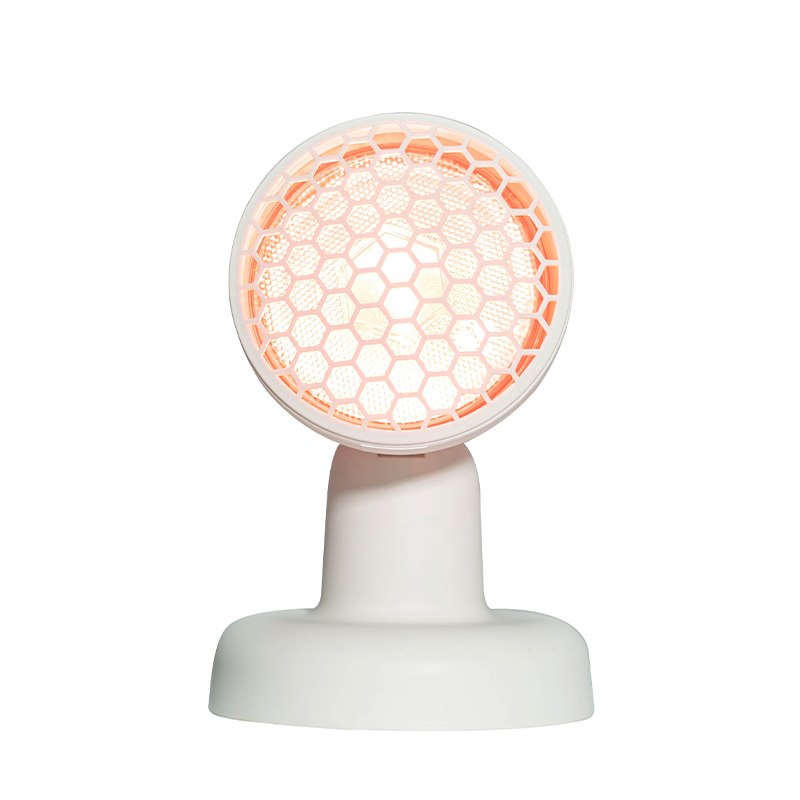

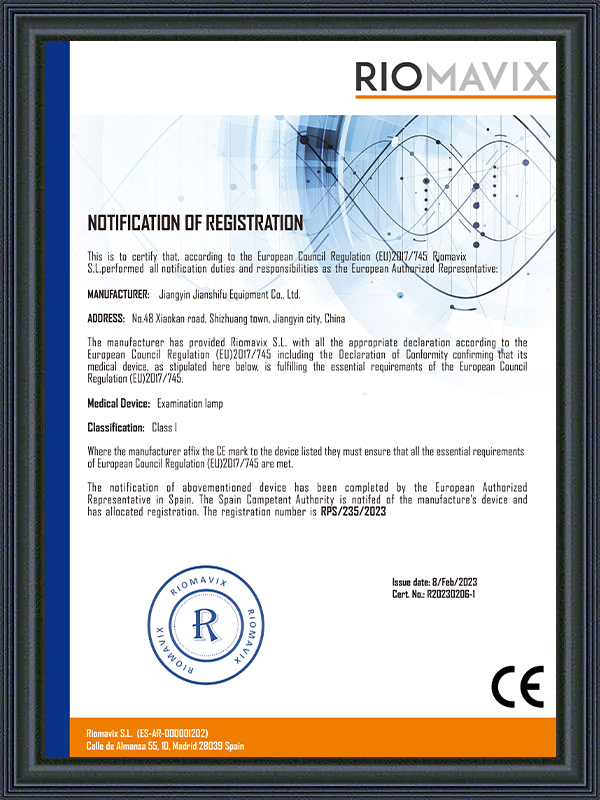
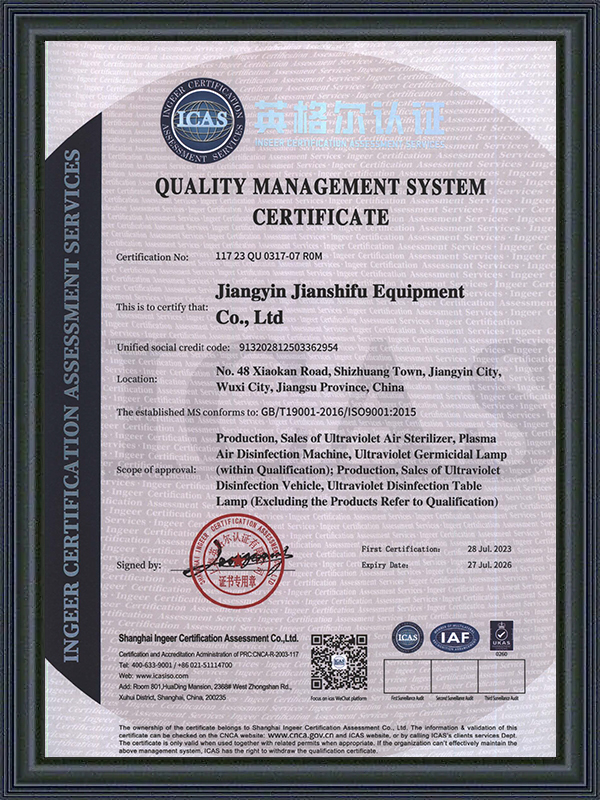
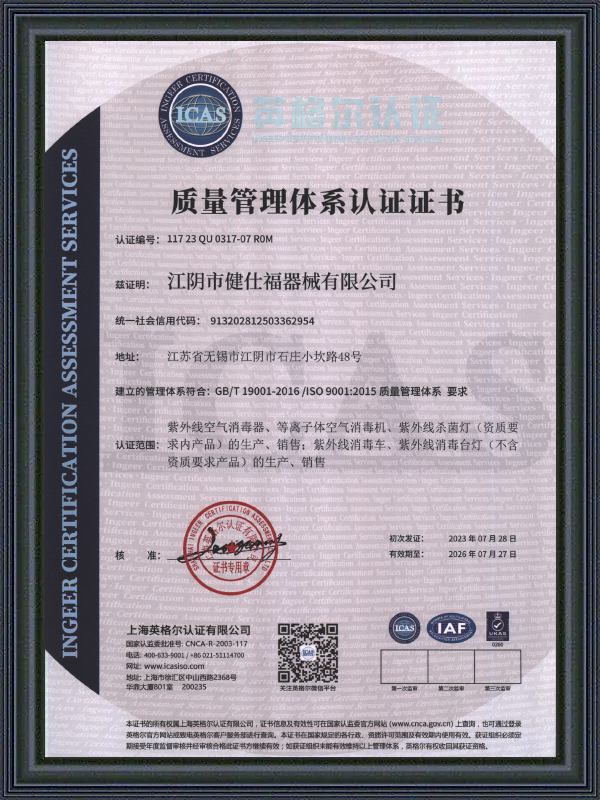
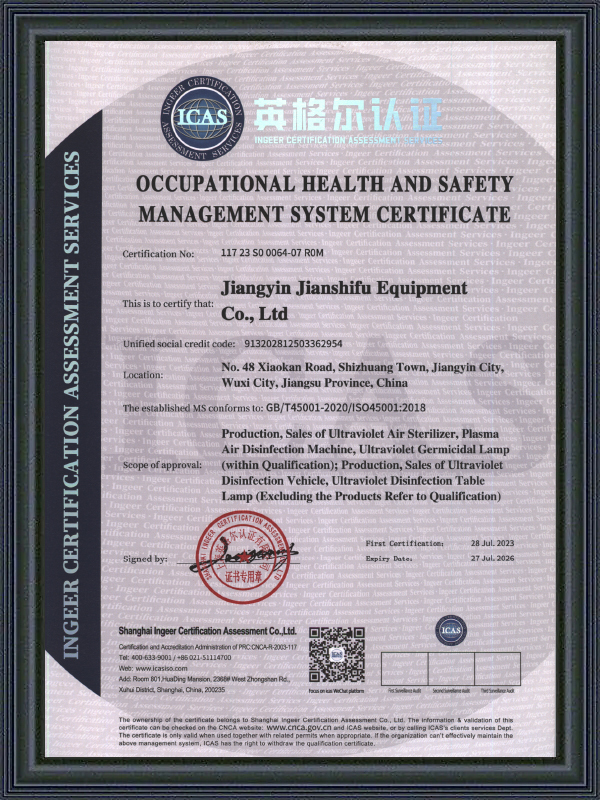
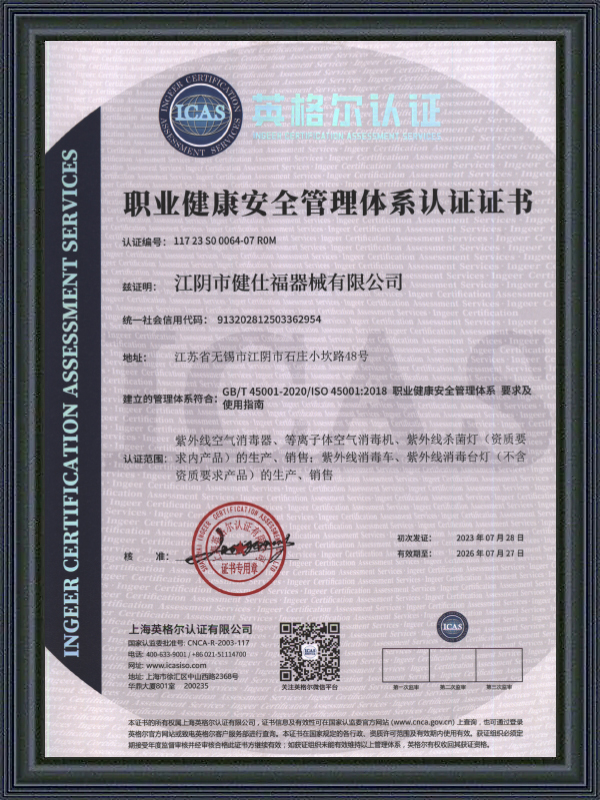
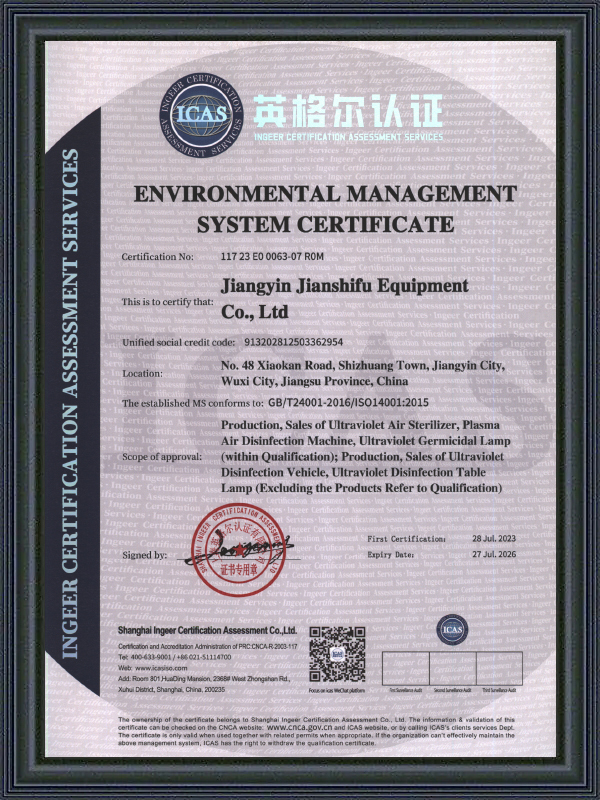
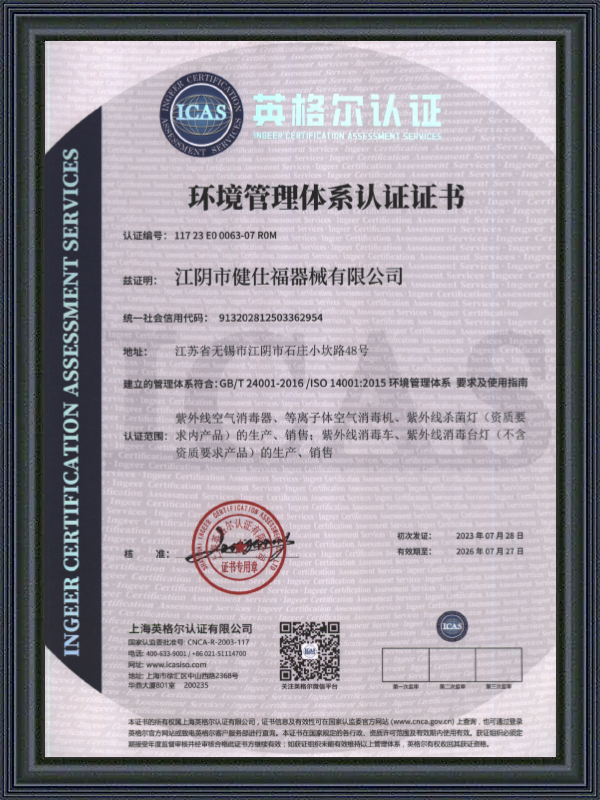

 No 48 Xiaokan Rd, Shizhuang town, Jiangyin, Jiangsu, China
No 48 Xiaokan Rd, Shizhuang town, Jiangyin, Jiangsu, China sara@jsf-qx.com
sara@jsf-qx.com +86-18915253915
+86-18915253915 +86-18861287595
+86-18861287595